本帖最后由 满仓 于 2014-2-10 10:28 编辑
【中文标题】“小胖子”和“小小男孩”
【原文标题】The Recipe for Good Government
【登载媒体】外交政策
【原文作者】Adam Rawnsley、David Brown
【原文链接】http://www.foreignpolicy.com/articles/2014/01/29/the_littlest_boy_cold_war_backpack_nuke]http://www.foreignpolicy.com/articles/2014/01/29/the_littlest_boy_cold_war_backpack_nuke[/url]
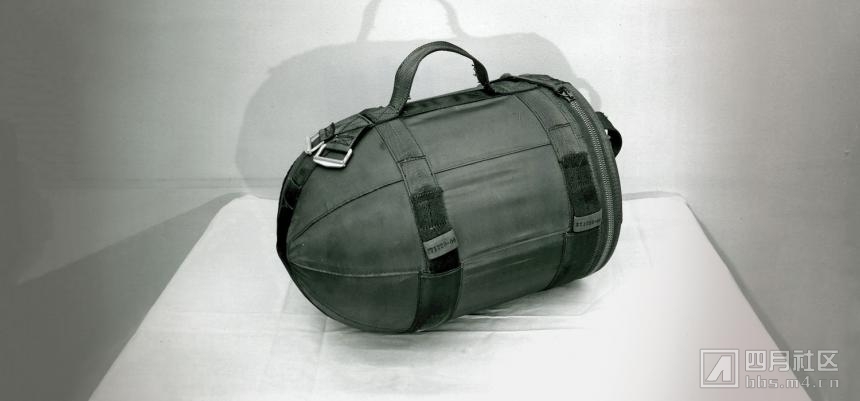
汤姆•戴维斯上尉站在军用运输机的尾板上,夜风吹过他的脸颊。他的眼睛搜索着1200英尺以下的地面。他紧紧握住降落伞的背带,深呼了一口气。
戴维斯和几位特种部队先遣组的男人们都是经过高强度培训的美国士兵。这是在1972年,戴维斯刚刚离开越南不久,他在那里的任务是沿柬埔寨边界巡逻。他的通讯士官曾经在北部命令控制中心工作,这个机构负责在越南北部运作一些最危险的行动。但他们都没有接受过现在这样的任务。
他们的计划是:空降到东欧,在隐蔽的状态下翻越丛林密布的群山,摧毁一座用来制造核武器的重水工厂。
行动开始之前,他们进行了为期4天的准备,地区军事专家给他们介绍了潜入的路线和可能遇到的敌军巡逻队。先遣队仔细研究了航拍照片和一个精心制作的目标模型——一个巨大的U字型建筑物。它坐落在一片开阔地,有不固定的哨岗,但至少小队不用潜入其内部。戴维斯的情报官的降落伞上,笨拙地挂着一个58磅的核弹。携带着如此威力巨大的武器,他们只需要把它靠墙放好,设定计时器,剩下的事情让核子分裂来完成。
戴维斯本来的人生规划是追随他家族中著名的法学家们——他的父亲是一名律师,祖父是联邦法院的法官——直到他在法律学校一年级时收到了征兵通知。戴维斯没有应征入伍,而是进入了候补军官学校,志愿加入特种部队。他后来在最困难的“Q专业”毕业,成为一名少尉。从那以后,他又学习了越南语,参加了东南亚的战争,他的身份是民政事务和心理学军官。
在晋升为中尉之后,戴维斯有了自己的先遣队。队中的士官建议他们申请参加军队中所谓的“特殊原子破坏武器”训练,这是一种专门设计的核武器,用来在与苏联的战场上使用。他说:“管他呢,为什么不去?”他们的连长向上级提报了他们的名字,先遣队于是开始了培训。
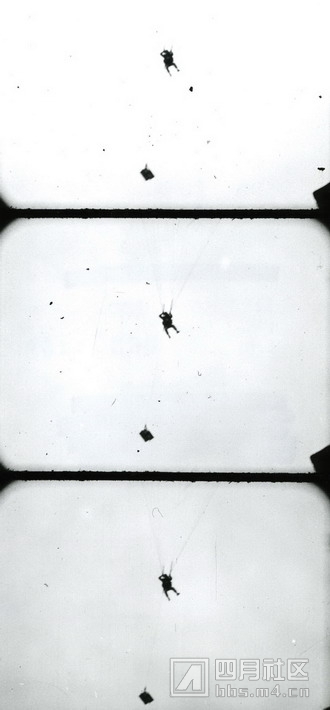
空降兵测试携带特殊核武器进行水上跳伞,核武器用一根绳子挂在他下面。
飞机接近的空降区,跳伞命令夹杂着刺骨、震耳欲聋的风声传过来。“检查开伞拉绳!”一个男人在后面喊道,“准备!”。绿灯亮起,每个人都被另外一个人拍下肩膀:“跳!”每个士兵都携带70磅重的装备,再加上30磅的伞具,都算不上“跳”,而是像鸭子一样歪歪斜斜地从飞机尾部以每秒20英尺的速度跌入大气层。
不到半秒钟,他们的轮廓出现在飞机尾部,刚打开的伞拖在身后,就像彗星的尾巴。伞面迎风展开,先遣队成员迅速落向地面,速度很快以躲避侦查(或射击),但又不至于在接触地面时受伤。小队降落之后,迅速收起降落伞并藏好,他们偷偷摸摸地沿着丛林来到预先定好的集结地。他们在那里打开特殊的容器,检查是否有损坏和泄漏,然后把炸弹装入帆布背包,掩埋容器。之后他们沿山路前进,为防止被发现,只在晚上活动。
他们花了两天时间到达目的地。在行动的那一天,他们在工厂周围装好炸弹,然后迅速离开。

戴维斯上尉的“任务”其实是一个演习。实际上,他和小队成员没有降落在东欧,而是新罕布什尔附近的白山国家森林公园。所谓的重水工厂其实是林肯镇附近一个废弃的造纸厂,炸弹也是一个仿造品。
这项任务并不是真实的,但他们的工作内容绝不掺假。
25年来,在冷战的后半期,美国的确开发出可随身携带的核武器,其武器型号是B-54“特殊原子破坏武器”。

特种部队使用这样的容器在空降时保护炸弹。容器和里面的武器非常沉重,空降兵的负重要增加90磅。
来自军方工程部队、特种部队、海豹突击队和海军陆战队的精英成员接受培训,准备在东欧、朝鲜和伊朗战场上使用这种炸弹——被称为“背包核弹”,这是美国军方保持遏制政策的努力,也是在必要情况下击败共产主义军队的手段。
在与苏联对峙的过程中,西方纠结于一个恐怖的事实,从战斗人员和传统武器军备数量角度来看,华沙条约缔约国的力量要远远强于北约组织。而对美国来说,核武器是确保双方实力均衡的关键因素。50年代,德怀特•艾森豪威尔更进一步,开启了“新面貌”政策。如果遭受到任何方式的进攻,将采取同归于尽的核打击——这个政策被称为“大规模报复”——以此来作为震慑苏联咄咄逼人的进攻态势的廉价应对方案。艾克(译者注:指艾森豪威尔)认为他可以据此来遏制国外的共产主义和国内的军事产业复合体。
这个策略有一个重大的缺陷。尽管“大规模报复”有其经济上的可取性,但它让美国在应对敌方侵略时几乎没有回旋的余地。如果共产党军队实施了一个有限度的、非核武器的进攻,那么总统不得不选择屈服于一个传统武器占优势的军事力量,或者选择完全不成比例的(也是自杀性的)核武器报复,这将导致数亿人的死亡。
为了在“赤化”和“死亡”之间增加一个选项,美国很快制定了有限核战争的策略,率先研制出可以在战场上使用的战术原子武器。如果华沙条约缔约国从东德和捷克斯洛伐克入侵西欧,美国可以利用这种核武器来阻止共产党长驱直入,直到援军到达。这些“小型”核武器大多比广岛原子弹的威力更大,它们可以摧毁整个战场,并辐射周边地区。但这毕竟是一个选择。
冷战期间充满了像“有限核战争”一样的矛盾形容法,但背包核弹或许是在面临无比真实的末日大决战时代中,最具黑色讽刺色彩的物品。特殊原子破坏武器就是一个活生生的讽刺,它就像斯利姆•佩金斯在《奇爱博士》影片结尾的演出(译者注:佩金斯扮演的主角骑在核弹上飞向苏联),美国士兵背着核弹从飞机上跳出的场景作为第三次世界大战的开场。

50年代和60年代是核武器设计的黄金年代,洛斯阿拉莫斯和桑迪亚核武器实验室里的科学家和技术人员,成功地把首次核试验所使用的将近1万磅重的原子弹庞然大物,缩小到导弹可以携带的尺寸。火箭学家也在陆地和潜艇可以发射的弹道导弹上配备核弹头。再加上轰炸机携带的核弹,形成了震慑苏联的核武器“三驾马车”。
从军事学角度来看,轰炸机和导弹分别由空军和海军掌控,陆军似乎被排除在战争史上最伟大的进步之外,即使陆军士兵在阻止苏联入侵西欧中做出了最主要的贡献。然而幸运的是,很多美国战略人士依然把核武器视为威力比较强大的传统炸弹,广岛之后,美国人对原子破坏技术尖端科技的掌握,给设计者灌输了一种一切皆有可能的思想。结果是出现了一些列古怪的发明,让核弹也进入了陆军的武器库,从原子大炮到配备核弹头的防空导弹。
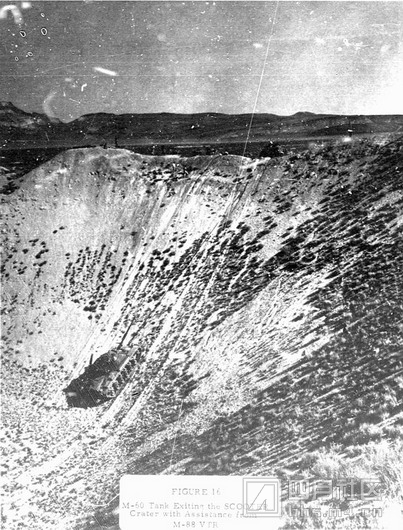
这是1969年进行的一项研究,军方从一个模拟的半千吨原子破坏武器形成的弹坑中,把一辆M-60坦克拖曳出来,以测试武器对敌方军事行动能力造成的影响。
军方在1954年开始了“原子破坏武器”计划。早期的产品是庞大、笨重的武器,重达数百磅,需要几个人借助卡车和直升飞机来移动它们。这些武器的目的主要是制造所谓的“核景观”——具有放射性的、无法通过的弹坑,或者炸毁山峰,堵死通道,以阻止敌人进攻。一名工程师回忆在丛林中引爆原子破坏武器的场景:“目的是摧毁峡谷中的树木,给敌方车辆和军队造成具有放射性的物理障碍。”
军方的反移动性战地手册教给士兵如何使用原子破坏武器来产生“河流弹坑”,也就是在小型水域附近使用原子武器,可以“形成一个临时的堤坝、积蓄湖水、让河流决堤,以及给敌人形成有效的水域阻隔”。

原子破坏武器项目参与者使用的军方战地手册。
背包核弹的使用方法——原子破坏武器军方战地手册中的图片。
如果出现了最糟糕的情况,军方的原子工程师将否认利用盟国的基础设施,来摧毁桥梁、隧道和堤坝。铁路、院落、电厂、机场,所有这一切都是先发制人的核武器破坏行动的对象。
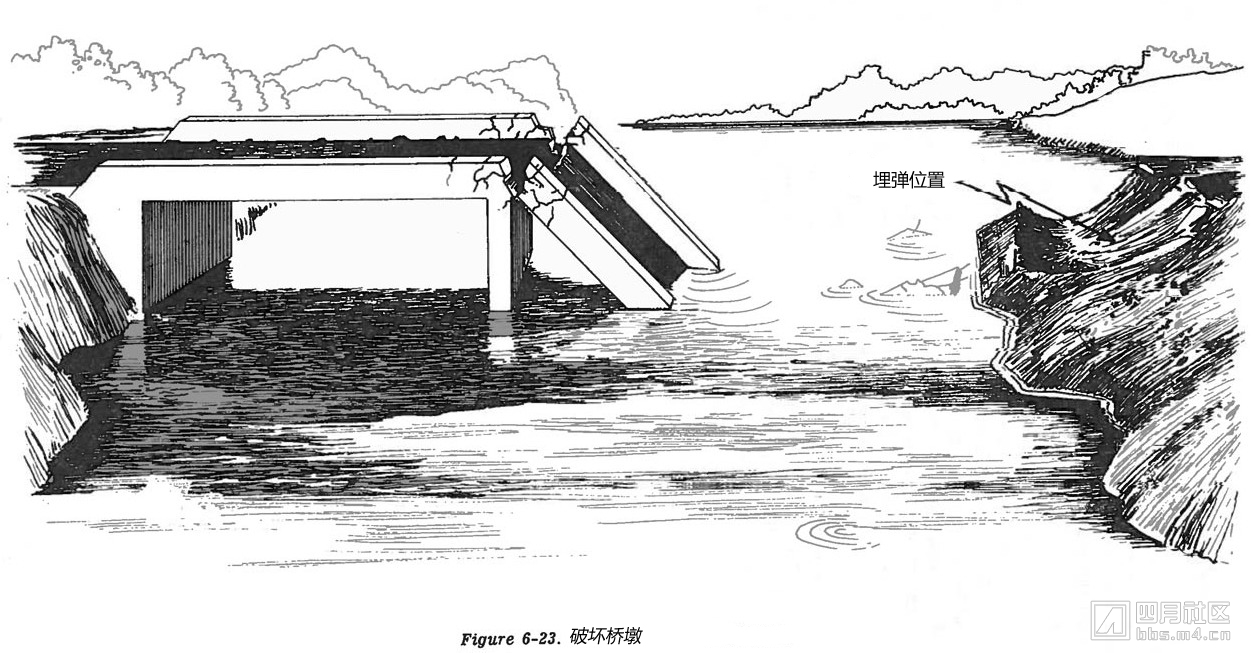
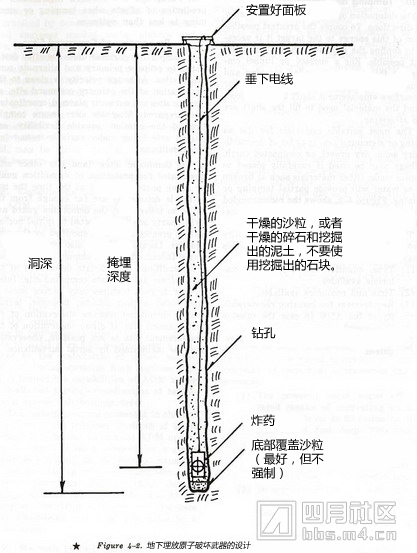
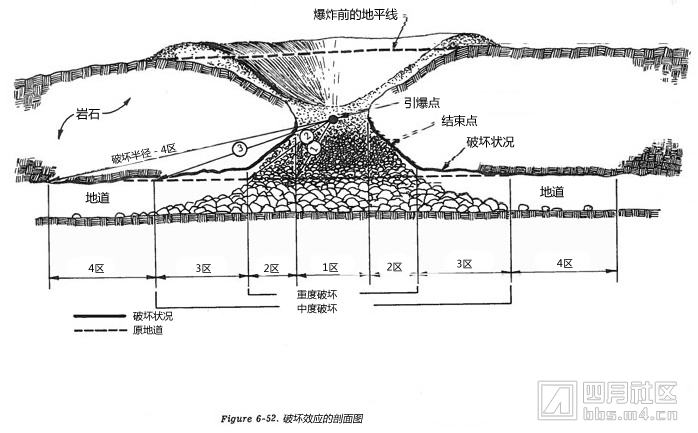


但军方依然需要一种更主动的核武器,军方的党派人士称大规模报复政策让美国无法应对全面的战争。原子能委员会的文件显示,美国的核武器研发者很乐意支持军方开发战术核弹的要求。据原子能委员会记载,桑迪亚公司总裁James McRae遗憾地说:“不加选择地滥用核武器比较导致公众的反对情绪。”由于未来的战争模式主要是“不间断的局部冲突,而不是大规模的战争”,McRae建议“主要关注小型核武器的开发”,用于“局部的地面战争”。
McRae的建议最终促成了名为“大卫•克洛科特”的次千吨级别核弹头火箭的研制成功,它可以被安置在吉普车的后面。1958年,当军方刚开始研究可以单兵携带的原子破坏武器时,原子能委员会主要考虑的是克洛科特的轻量级马克54核弹头。他们需要的是一个更小、更机动版本的原子破坏武器。当然,军方不得不与海军和海军陆战队分享这个装备。
原子能委员会的最终产品是B-54型特殊原子破坏武器,它在1964年开始量产。这个设备高18英寸,装在一个铝制的玻璃纤维容器中。一头类似子弹形状,另一头有一个直径12英寸的控制面板。据军方手册的介绍,这个武器的最大威力小于1千吨,也就是小于1000吨TNT炸药的当量。为了保护炸弹不被误引爆,特殊原子破坏武器的控制面板上有一个盖子,上面用密码锁住。锁上的夜光涂料让士兵可以在夜间解锁。
如果苏联入侵某个国家,比如西德,特殊原子破坏武器可以让特种部队(绰号“绿灯”)部署在敌方后部,摧毁基础设施和军备库存。但它的使命不仅仅限于北约国家。很多核武器历史学家并没有意识到,绿灯特种部队还准备在华沙条约国家内部使用特殊原子破坏武器,来挫败入侵的企图。特种部队可以破坏敌方飞机场、坦克阵营、防空网络关键节点和运输设施,以避免敌军蜂拥而入,并让盟军空军有可乘之机。根据内部的一份报告,军方还曾好绿在敌方掩体内埋放特殊原子破坏武器,“破坏现场指挥和通讯设施”。
海豹突击队和空军接受的训练是从空中、陆地和海上接近目标,他们还可以利用运输机或者直升飞机空降到敌人的大后方。有水下作战能力的士兵可以在必要时携带炸弹到达目的地。(原子能委员会设计了一种可以密封加压的容器,潜水员携带炸弹可以潜入200英尺的水下。)甚至还有一名特种兵被培训携带武器从巴伐利亚阿尔卑斯山脉滑雪而下,但并没有成功。曾经指挥一支原子破坏武器特种部队的比尔•弗莱文说:“炸弹滑到了山下,但是你没有。只要稍微偏离一点,你就无法控制方向。”
特种部队因此开始培训队员携带武器进行高空跳伞和潜水。队长可以选择哪个队员要接受武器操作的培训,以便通过军队的定期、强制性的核武器安全检查。弗莱文说:“服役记录最优、经验最丰富的人通常会进入特殊原子破坏武器小队,因为他们必须通过检查。”要得到特殊原子破坏武器的操作资格,士兵还必须通过国防部的可信赖程度筛查,以确保他们值得相信、心理稳定。
有机会参与项目的士兵雄心勃勃,其他人则垂头丧气。
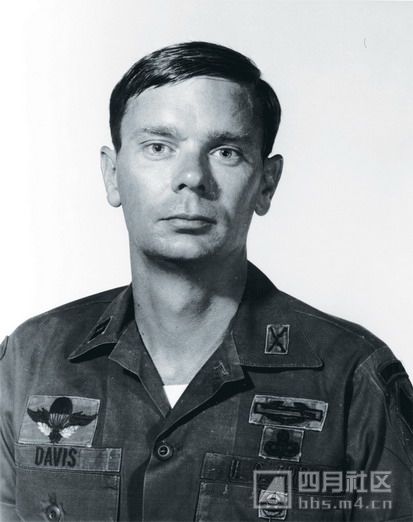
汤姆•戴维斯上校(已退役)在第十特种部队时领导一支特殊原子破坏武器小队(空军)。
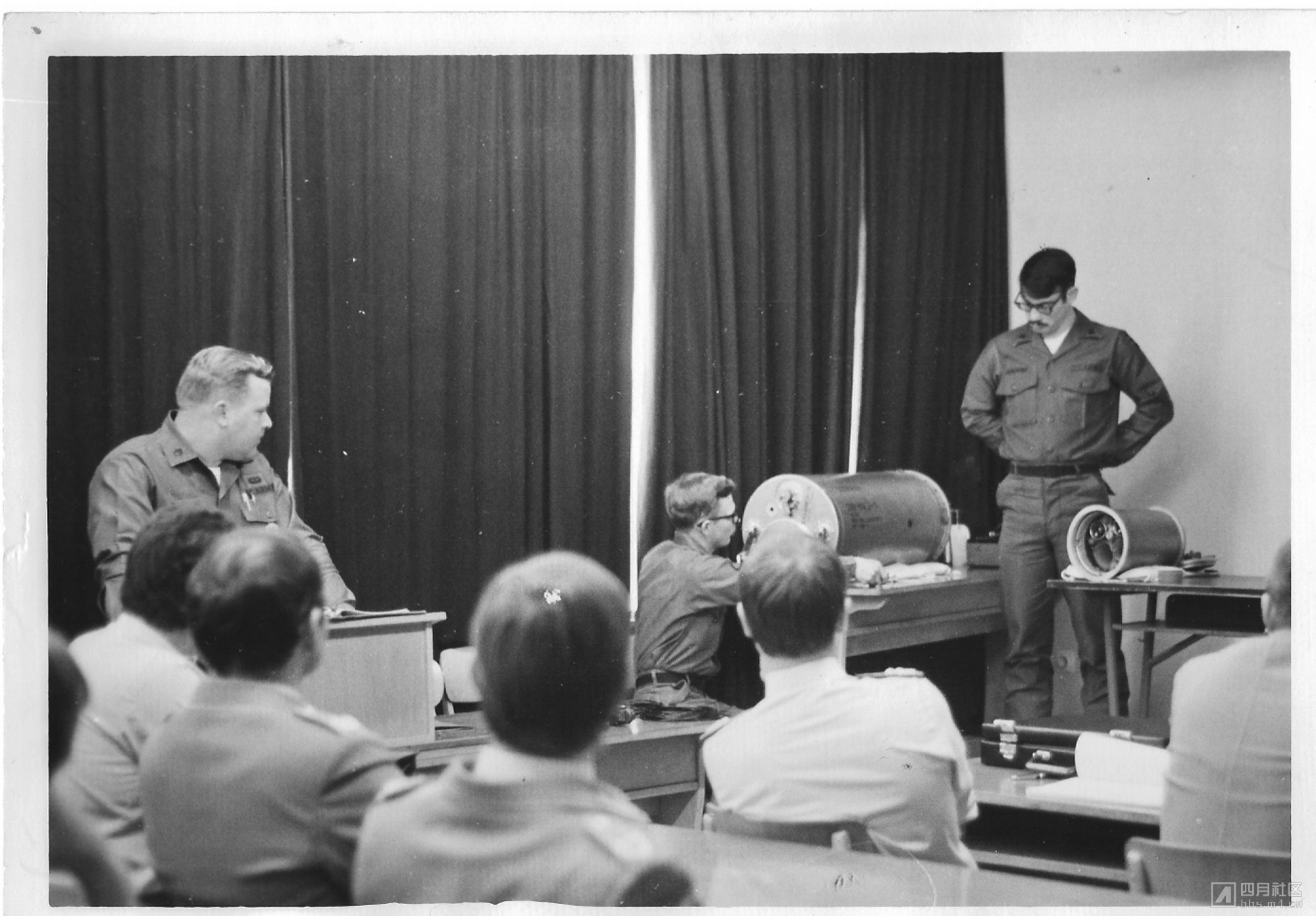
士兵在课堂上接受培训使用中型原子破坏武器——特殊原子破坏武器的老大哥,它一般重达400磅,需要一队工程师借助直升飞机或卡车的帮助才能搬运。中型原子破坏武器的威力为1到1到15千吨,可以通过计时器、电线和无线电引爆。
戴维斯上尉说:“每个人当然都想报名,候选人不是问题,因为人们都觉得这是个新鲜事,都想学习一下。”但是当绿灯队员肯•里克特接受面试时,他发现并不是所有人都热衷此事。“我面试了很多人,当他们听说任务的具体内容之后,都会说:‘不,谢谢,我宁可回到越南。’”
当他第一次见到这个武器,里克特简直不敢相信原子能委员会能造出这样的东西。他说:“我的第一反应是不敢相信,我之前见过的都是二战时期的这类武器,体积巨大。现在,我们要把它放在背包里?他们不是在开玩笑吧。”这并不是玩笑,特种部队特殊原子破坏武器小组也像戴维斯的部队一样,接受为期一周的培训,他们每天在佐治亚州贝宁堡的教师中每天学习8到12个小时。他们还要定期学习新的知识,负责教学的是特种部队原子破坏武器小组委员会,其中也包括一些经过认证的非委员会成员。学员必须接受定期的检查,以确定他们是否适合操作核武器。但由于核武器的高风险性,培训也难以建立起足够的信心。
从一个核武器的意义上说,这种炸弹是小巧、轻便的,但是以步兵的装备看来,它依然是个笨重的家伙,背负者的负担可不小。特殊原子破坏武器小组的通讯士官丹尼•鲍尔斯说:“跳伞指挥官说‘跳’的时候,他们几乎是把我和后背的炸弹丢出飞机。”
把武器挂在脚上,移动起来就更困难了。一名原子破坏武器工程师丹•道森回忆背负着核弹奔跑有多么的困难。在一次演习中,他的小队的任务是炸毁一个铁路隧道,但他们发现很难让一个特殊原子破坏武器通过一片开阔地。“要想迅速地背着特殊原子破坏武器通过这片开阔地,我们两个人,每人一边架着他的胳膊小跑过去。你一个人根本背不动,也不能奔跑。”
而且还有一个双人原则,到今天为止依然规定单人不能启动核武器,这就要求绿灯特种部队的两个人分别掌握部分的控制面板开启密码。但如果有人在执行任务中阵亡该怎么办?弗莱文说:“你背着这个沉重的烂家伙无处可去?所以我们决定:‘别出现这样的情况。’”他的队员决定在真正执行任务时,两个人可以分享对方的密码。
这并不是说特种部队在任务失败时可以丢弃特殊原子破坏武器。武器的独特威力说明它不能落在敌人手中,用密码锁定的盖子没有太多的保护作用。弗莱文说,即使敌人没有活捉特种部队成员,“用一个撬棍也可以把它打开。”因此队员也接受了销毁武器的培训。鲍威尔说:“我们随身携带着足够数量的炸药,以便在不引爆核武器的情况下摧毁它。这或许造成了一些核物料的浪费,但至少不会出现一朵蘑菇云。”
如果小队到达了目标所在地,他们要打开控制面板的盖子,设定计时器。然后他们开始操作安全阀——位于控制面板左上角的一小块区间。他们需要拿出手掌大小的引爆器,它的作用是激活核弹的连锁反应,在把引爆器插入并打开开关之后,他们要做的就是不顾一切地撤退。
当然,在爆炸前的数小时或者数分钟时间里,炸弹有可能被敌军发现,所以一些特种部队得到的指示是他们必须要盯住炸弹,直到爆炸前的几分钟。弗兰克•安蒂诺里是特种部队核武器维护技师,后来因为在伊拉克和阿富汗绿色贝雷帽行动中的英勇表现而得到勋章。他说,不同的教员对确保武器安全和人员安全的“恰当”距离有不同的说法。有人告诉队员一旦安置好炸弹就要迅速离开,也有人坚持认为队员必须确保武器在视野范围内,直到爆炸。
即使在“安全”距离以外,特殊原子破坏武器小队依然会感到靠近爆炸点所造成的不舒适感。安蒂诺里说:“我们虽然身处汽化区以外,但仍然能感到‘爆炸一秒钟之后吹来的热风’。”
比故意围在一颗即将爆炸的核武器旁边更加荒唐的一件事是,这些人根本不知道它会在什么时候爆炸。或许是为了防止电磁脉冲的干扰——这是与苏联爆发战争时最有可能发生的现象——原子能委员会让特殊原子破坏武器在最大程度上不采用电子器件。设备依赖的是两个机械计时器,所以时间设置的越长,它也就越不准确,有可能会提前8分钟,或者延后13分钟。军方的战地手册警告,“不大可能推算精确的时间”,所以特殊原子破坏武器小组要学会预测大致的爆炸时间。
尽管如此,鲍威尔说:“我们总是谨小慎微地完成所有的细致步骤,我们把计时器设置为几个小时,然后离开。但当我们旋开开关时,必须要尽快逃离。”
如果绿灯小队有足够的运气活着离开爆炸现场,他们生存下来的机会也微乎其微。在第三次世界大战中身处敌境、没有补给,他们必须依赖自身的智慧和潜伏训练来躲避追杀。当然也有一些储备物资供他们使用,逃离特殊原子破坏武器爆炸现场的特种部队,可以参照一张特殊的地图,在东欧国家境内找到武器和补给。弗莱文回忆说:“柏林墙倒塌之后,我们取回了这些藏品。我很吃惊,这些武器和补给保存得非常好。”

朱利叶斯•莱尼茨尔被同事们称为“大熊”。这位出生在捷克斯洛伐克的特种部队中士,负责指导特殊原子破坏武器部队如何在敌后生存。
除了这些储藏所,特殊原子破坏武器小队还有一件能帮助他们回家的秘密武器:一位出生在捷克斯洛伐克的特种部队中士——朱利叶斯•莱尼茨尔。在十多岁的时候,莱尼茨尔两次逃出波兰的纳粹集中营。他与美国军事情报机构建立了联系,跨国边境成立了一个反抗组织。他后来被共产主义建立斯洛伐克逮捕并监禁,但他再一次逃脱。回到自由世界之后,莱尼茨尔加入了美军,获得了美国国籍,成为了绿色贝雷帽成员。他被称为“大熊”,是包括弗莱文在内的特种部队宝贵的信息来源,他的授课内容是在铁幕下逃生的艺术。
尽管如此,绿灯任务是有去无回的概念始终萦绕在特种部队成员的脑海中。飞越敌军领空、在敌人后方秘密行动、携带核武器躲避追捕、在炸弹附近等着它爆炸——这一切都似乎是荒唐可笑的。就像弗莱文所说:“这个项目的可操作性的确是有些问题,执行任务的人敢肯定,计划的制定者肯定是吸了过量的大麻。”
幽默缓和了原子破坏武器工作的残酷现实。原子破坏武器工程师制作了一些蘑菇云的标志图案,小队成员还自己创造了一些口号:“炸得他们发光,射得他们发黑。”这种幽默是可以理解的,因为有人相信,军方的行政系统下达核爆任务的可能性非常小。戴维斯说:“在我们心中,我们知道没人愿意把核弹交给几个大孩子,让他们背着它在深山里乱跑。我们觉得没有这种可能。”
除了项目设计方面的“硬伤”,弗莱文说,有些特种部队成员怀疑,在第三次世界大战混乱的开场中,先不管武器的问题,用来空投他们的飞机能否及时到达?特殊原子破坏武器部队几乎从未接触过真正的核弹,它们都被存放在严密监管的武器库中,比如西德米骚的军火库。如果战争爆发,先要把武器从库中运送到最近的机场,特种部队在那里等待。弗莱文总结了准备工作中的挑战:“所以你需要先找到我们,然后找到武器,再找到飞机,该什么时候完成这些事情?我猜必须要在对方知道我们准备进攻之前。”
在政治层面也存在一些问题。北约盟国,尤其是西德,对于美国在他们的国家里引爆若干小型核弹的做法极为焦虑。工程师的原则是疏散所有居民之后才会启动核武器,但这并未平息民众的情绪。把武器埋在地下可以限制放射沉降物,但是当美国征求西德批准在运输设施附近挖掘核弹坑时,遭到了当地居民的反对。

最终,所有对特殊原子破坏武器的质疑都没有得到满意的回答。1984年,武器诞生的20年之后,自然资源保护委员会的威廉•阿尔金和他的同事从军方的文件中找到了有关特殊原子破坏武器的内容,民众开始了解到相关的细节。他的发现引起了国会的愤怒和媒体的震惊,但这个武器毕竟已经时日无多。
冷战的紧张局势逐渐缓和,美国开始把特殊原子破坏武器收回国内。这种武器在1989年正式退役,国防部和能源部宣布它已经“过时”,而且“已经不会再有实际需求”。随着苏联在1991年解体,乔治•H•W•布什全面削减了非战略性核武器的研制预算。
6年后,武器的一些细节被官方解密。但是美国军队如何使用背包核弹的细节,包括华沙条约缔约国内的军事行动、安置炸弹的士兵任务内容、行动的风险等,只能通过参与人的采访、信息自由行动的解密文件和新发现的军事手册才能逐步获取。
曾经被列为高度机密的武器现在是吸引游客的噱头。今天,到新墨西哥州阿尔布开克的美国政府核科学和核历史国家博物馆参观的游客,可以在一个空投容器前拍照。特殊原子破坏武器已经从一个极为严肃、古怪的武器变成了冷战的恶俗作品。
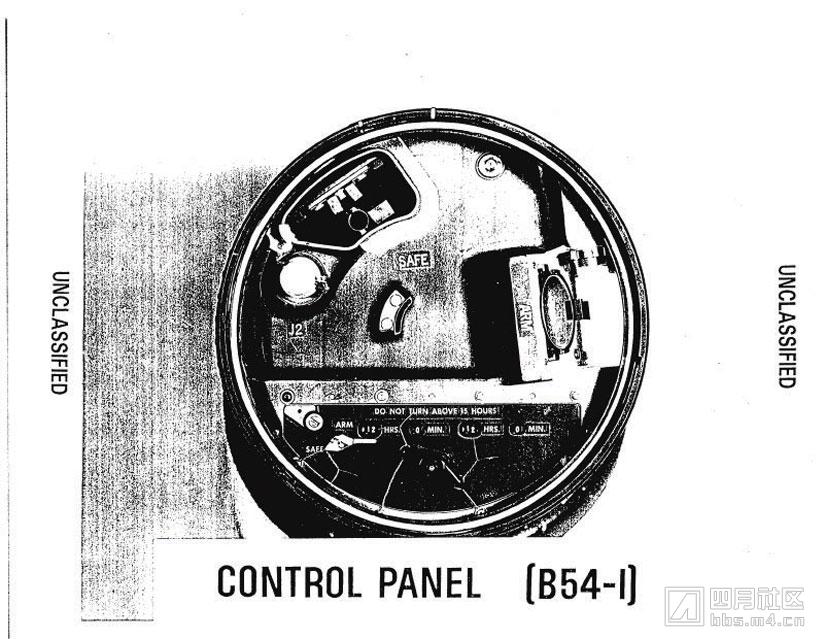
特殊原子破坏武器的控制面板。
历史逐渐远去,人们很容易把特殊原子破坏武器当成冷战癔症下形成的怪胎。但是美国依然在欧洲部署着战术核武器,但形式是不那么危险的B61空投炸弹。更可怕的是,其它国家开始把这种武器当作国防工具。例如,巴基斯坦在积极发展核武器,并且有计划装备给战场上的士兵,这是对印度庞大军事力量的回应。风水轮流转,俄罗斯发现在面对北约的传统武器时,自己处于劣势,莫斯科于是加紧了战术核武器的研制。
然而,对于军方的特殊原子破坏武器老兵来说,核武器已经称为了历史。有些人对他们的任务持怀疑态度,有些人深信不疑。无论如何,他们现在的背包里装的不是核武器,而是冷战的噩梦。
原文:
As Capt. Tom Davis stands at the tailgate of the military cargo plane, the night air sweeps through the hold. His eyes search the black terrain 1,200 feet below. He grips the canvas of his reserve parachute and takes a deep breath.
Davis and the men who make up his Special Forces A-team are among the most highly trained soldiers in the U.S. Army. It's 1972, and Davis isn't far removed from a tour in Vietnam, where he operated along the Cambodian border. His communications sergeant served in Command and Control North, which was responsible for some of the most daring operations in the heart of North Vietnamese territory. But none of the men has ever been on a mission like this before.
Their plan: drop into Eastern Europe, make their way undetected through forested mountains, and destroy a heavy-water plant used in the manufacture of nuclear weapons.
Leading up to the operation, during four days of preparation, Army regional experts briefed them on routes of infiltration and anticipated enemy patrols. The team pored over aerial photographs and an elaborate mock-up of the target -- a large, slightly U-shaped building. It's situated in a wide, open area with a roving guard, but at least the team won't have to sneak inside. Hanging awkwardly from the parachute harness of Davis's intelligence sergeant is a 58-pound nuclear bomb.Hanging awkwardly from the parachute harness of Davis's intelligence sergeant is a 58-pound nuclear bomb. With a weapon this powerful, they can just lay it against a wall, crank the timers, and let fission do its work.
Davis had planned to follow in the footsteps of his family's prominent jurists -- his father was a lawyer; his grandfather a federal court judge -- until a notice from the draft board arrived during his first year of law school. Rather than be drafted, Davis signed up for officer candidate school and volunteered for Special Forces, graduating from the demanding "Q course" as a second lieutenant. From there, it was on to Vietnamese language school and off to the war in Southeast Asia, where he served as a civil affairs/psychological operations officer.
As a first lieutenant, Davis got his own A-team. His team sergeant suggested they volunteer for training with what the Army called Special Atomic Demolition Munitions -- tactical nukes designed to be used on the battlefield in a war with the Soviets. "What the hell. Why not?" he responded. Their company commander forwarded their names and the team was accepted for training.
|
